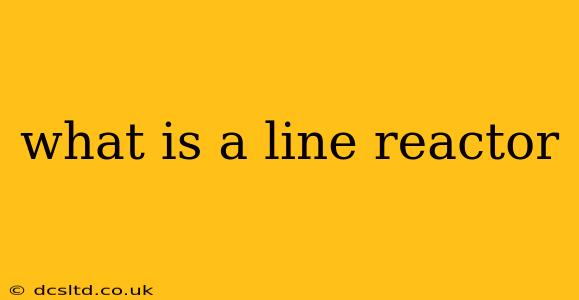A line reactor, also known as a smoothing reactor or a series reactor, is a passive electrical component used in power systems to limit the flow of short-circuit currents and to reduce voltage fluctuations. It's essentially a large inductor—a coil of wire—designed to offer significant impedance to alternating current (AC) while having minimal resistance. This seemingly simple device plays a crucial role in ensuring the stability and safety of electrical grids and industrial power systems.
How Does a Line Reactor Work?
The core function of a line reactor stems from its inductive reactance. When AC current flows through the inductor, it creates a magnetic field. This magnetic field opposes changes in the current, limiting its rate of increase or decrease. This opposition is measured as inductive reactance (XL), expressed in ohms. The higher the inductive reactance, the greater the current limiting effect.
In simpler terms, imagine trying to push a heavy object. The heavier the object, the harder it is to accelerate. Similarly, a line reactor makes it harder for large surges of current to flow quickly through the system. This is especially important during fault conditions.
Why Use a Line Reactor? Key Applications and Benefits
Line reactors offer several crucial benefits in power systems:
-
Fault Current Limitation: During short circuits, massive currents can flow, potentially damaging equipment and causing fires. Line reactors significantly reduce the magnitude of these fault currents, giving circuit breakers time to operate and protect the system.
-
Voltage Regulation: Line reactors help to stabilize voltage levels by smoothing out fluctuations caused by fluctuating loads or switching operations. This is especially critical in applications with large, variable loads like industrial plants or data centers.
-
Harmonic Filtering: Line reactors can help mitigate harmonic distortion, unwanted frequency components introduced by non-linear loads (like rectifiers and variable speed drives). This improves the overall power quality of the system.
-
Power Factor Improvement: In some configurations, line reactors can indirectly contribute to power factor improvement by reducing the reactive power demand of certain loads.
What are the Different Types of Line Reactors?
Line reactors come in various designs, tailored to specific applications and voltage levels:
-
Air-core reactors: These are the simplest type, with the coil wound around an air core. They are generally used for lower voltages and currents.
-
Iron-core reactors: These use a magnetic core made of iron or other ferromagnetic materials to increase the inductance and reduce the overall size for a given reactance. They are suitable for higher power applications.
-
Dry-type reactors: These reactors are typically air-cooled and are suitable for indoor or outdoor installations.
-
Oil-filled reactors: These reactors are immersed in oil for cooling and insulation, often used for higher voltage and current applications.
What are the Disadvantages of Using Line Reactors?
While line reactors offer numerous advantages, they also have some drawbacks:
-
Voltage Drop: The reactance of the reactor causes a voltage drop, reducing the voltage available to the load. This needs to be factored into the system design.
-
Power Loss: While minimal, there are some power losses due to resistance in the coil windings.
-
Size and Weight: Larger reactors can be physically bulky and heavy, requiring significant space for installation.
Frequently Asked Questions (PAAs)
This section addresses some common questions regarding line reactors. Note that the answers are general and specific requirements will vary depending on the application.
What is the difference between a line reactor and a choke?
While both line reactors and chokes are inductors, the term "line reactor" generally refers to a larger, higher-rated inductor used in power systems for current limiting and voltage regulation. "Choke" is a more general term and can refer to smaller inductors used in a wide variety of applications.
How is the size of a line reactor determined?
The size and rating of a line reactor are determined by the required reactance, voltage, current, and frequency of the power system. This is usually calculated by experienced electrical engineers based on the specific application requirements.
How do you choose the right line reactor for a particular application?
Selecting the appropriate line reactor involves considering several factors including the system voltage, current, frequency, required reactance, ambient temperature, and available space for installation. Consulting with a qualified electrical engineer is strongly recommended.
What are the maintenance requirements for line reactors?
Maintenance requirements for line reactors depend on the type (air-core, iron-core, oil-filled) and the operating environment. Regular inspections for overheating, loose connections, and signs of damage are important. For oil-filled reactors, oil level and condition should be monitored.
This comprehensive guide provides a strong understanding of line reactors, their functions, and their applications in the power systems industry. Remember that working with high-voltage electrical equipment is dangerous, and qualified professionals should always handle installation and maintenance.
